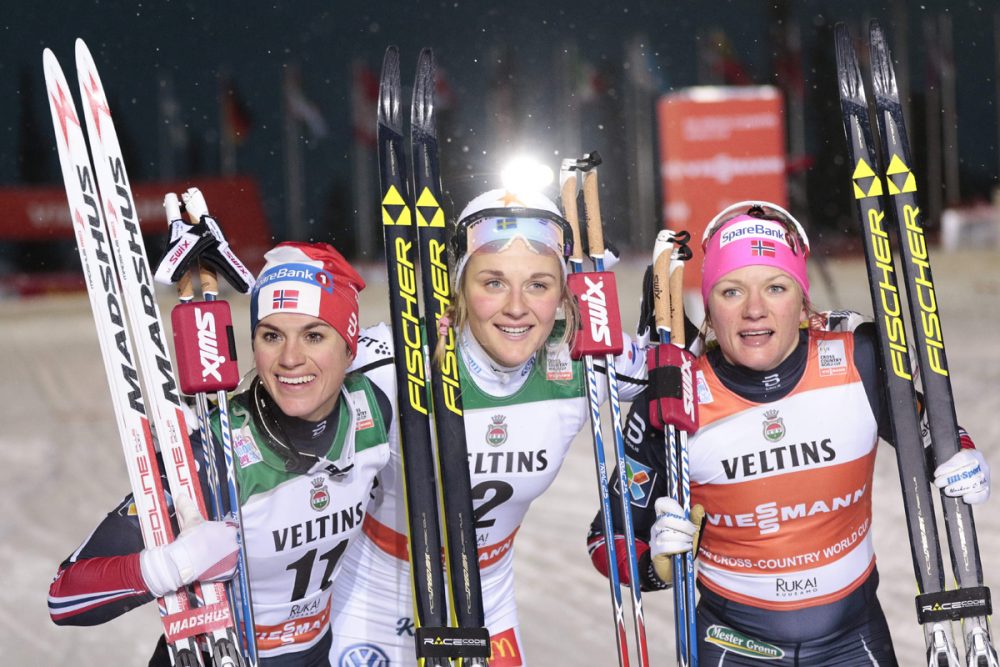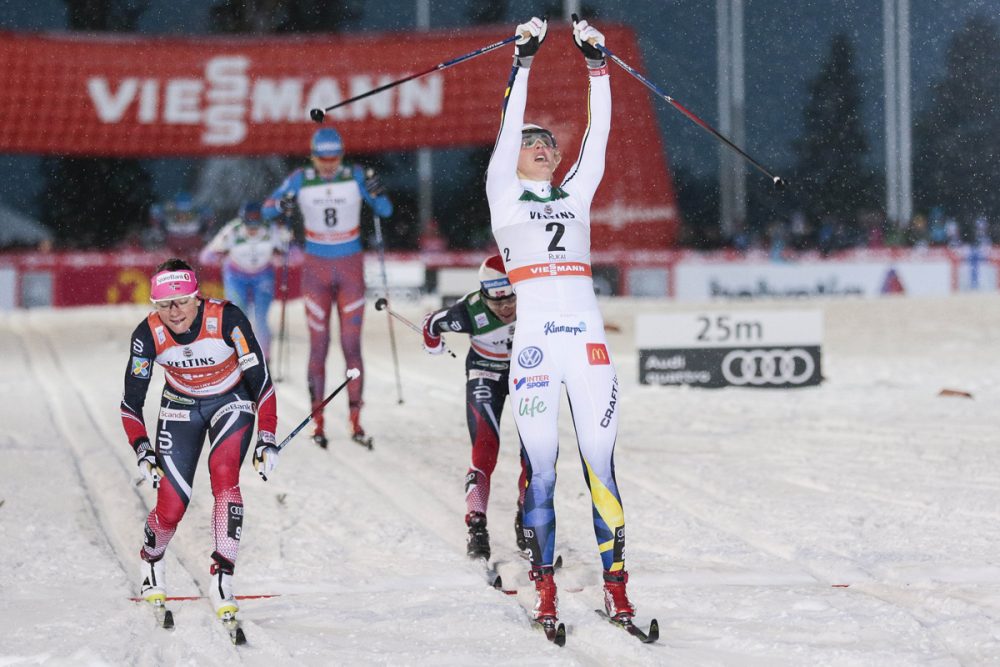
Norway’s women’s team has a long history with classic racing in Kuusamo, Finland. For 15 years, International Ski Federation (FIS) Cross Country World Cup competitions have taken place on these trails, with Norway winning every classic race at the Ruka venue except two — falling to Finland’s Aino-Kaisa Saarinen in 2009 and more recently, Poland’s Justyna Kowalczyk in 2013.
Three years later, another woman’s name has now knocked Norway’s out of first: Sweden’s Stina Nilsson.
In the women’s 1.4-kilometer sprint final on Saturday, Nilsson battled two Norwegians –including last year’s Sprint Cup winner, Maiken Caspersen Falla — two Russians, and a Finn, for her first title ever in a classic race.
“It feels super awesome, especially to win a classic race,” Nilsson, 23, said during a television interview.
After qualifying second, 1.14 seconds behind the winning qualification time of 3:21.15 set by Finland’s Krista Parmakowski, Nilsson overtook the lead by the end of the first quarterfinal and held it through her semifinal and the final.

Nilsson and Parmakoski started the day’s rounds in the first quarterfinal one, leading Kowalczyk and another Finn, Laura Mononen, as well as Russia’s Natalia Nepryaeva and Norway’s Astrid Uhrenholdt Jacobsen off the start.
Parmakoski pulled into the lead through the first major downhill, first major ascent and into the second major course descent. However, by the last large climb, Nilsson proved too powerful for the Finn. Within three strides, Nilsson passed Parmakoski and by the top of the hill had established enough of a gap to double pole her way safely across the finish line of her quarterfinal in first.
In a much closer semifinal, Nilsson found herself in fourth alongside her Swedish teammate Hannah Falk for most of the heat, tightly trailing Russia’s Natalia Matveeva and Norway’s Falla all the way through the second major descent. By the bottom of the final climb, it was Matveeva in front, with Falla working to her left. Navigating to the inside, Nilsson found a second wind, eventually outlasting both the Norwegian and the Russian in the race to the top.
Back in the lead with 100-meters to go, Nilsson once again crossed in first, leaving the photo finish to Falla and Matveeva. Falla automatically advanced to the final after capturing second, while Matveeva earned one of the ‘Lucky Loser’ spots. Parmakoski garnered the final’s last lucky loser spot after crossing fourth in Nilsson’s semifinal.
Facing off against Falla once more, as well as her Norwegian teammate, Heidi Weng–the winner of the second semifinal–along with Russia’s Yulia Belorukova and Matveeva, as well as Parmakowski in the final, Nilsson took no chances off the start.
The Swede punched the pace through the initial decent, but by the first major climb she began to lose steam. Falla challenged Nilsson on the right, while Matveeva closed in from the left. Weng hung on behind her teammate in fourth place, while Parmakoski raced in fifth and Belorukova in sixth.
Regaining the front position from Nilsson by the second large downhill on course, the sprint leader Falla appeared to be preparing to gap herself from the group. Midway through the final climb, however, the Swede’s white suit was once more on the attack. Fading into a chase pack by the top of the climb were Falla, Weng, and Matveeva, while Nilsson blew her way back into the lead.
With 100 meters to go, Falla jumped in behind Nilsson. With 50 meters to go, Falla switched lanes, moving to the Swede’s right in an effort to edge by for the win. Holding on tightly her first classic title, Nilsson double poled across the finish line first in a time of 3:21.61, while Falla finished 0.17 hundreths of a second behind her in second.
“I’m happy about the [second] place, it was a good start to the season and it shows promise for Lillehammer– it’s fun to be on the podium already,” Falla, 26, said during a television interview.
Falla’s teammate Weng rounded out the podium in third, crossing 0.69 seconds off of Nilsson’s time.
“I’m very happy, I’ve never had such a good season opener in Kusammo,” Weng, 25, said during a T.V. interview. “The conditions were challenging so we had use herringbone.”
Other final finishers included Matveeva in fourth (+3.18), Parmakowski in fifth (+5.12) and Belorukova in sixth (+8.94).
Four Americans Qualify; Bjornsen 17th

The U.S. Ski Team (USST) saw four women qualify for the heats on Saturday, with Sadie Bjornsen leading the group after qualifying in seventh (+4.41), followed by Jessie Diggins who qualified 13th (+6.27), Ida Sargent in 23rd (+10.28) and Sophie Caldwell, who nabbed the final qualification spot, in 30th (+11.84).
Though Bjornsen indicated that her preparation leading into the season has been different than in years past–due partly to a heel spur problem she has been nursing during the past two months, which forced her to engage in sans shoe training, such as swimming, ski erging, and heel-less biking–the 27-year-old saw Saturday’s performance as a good sign of where her training is taking her.
“Today was only my third time classic skiing in the past months, so it was great to finally find my classic ‘feeling’ this morning just before the start,” Bjornsen wrote in an email to media outlets. “The past few days I have been nervous, and questioning myself more than normal, so today was a wonderful ‘check’.”
A Winthrop, Washington, native who trains with Alaska Pacific University (APU) in Anchorage, Alaska, Bjornsen decided prior to the start of the 2016/2017 season that she would hold no expectations over herself, other than to give every race she entered a good fight.
With that in mind, she lead the start of her quarterfinal and pushed the pace early on. Following close behind her was the swiss skier Laurien Van der Graaff, Russia’s Daria Vedenina, Kerttu Niskanen of Finland, Norway’s Heidi Weng and Germany’s Sandra Ringwald.
Bjornsen held her lead until the final climb of the course, where the powdery snow appeared to slow down her ability to keep up a high turnover in her herringbone. She was overtaken by Weng and Rigwald before the top of the climb and crossed fourth in her quarterfinal for 17th overall.
“I had a great qualifier, and went into the heats with some confidence,” Bjornsen wrote. “The start was great, but I started to struggle on the final climb. I am missing a little bit of “high speed leg speed”, but that is something I am confident will come with using my legs again. I am looking forward to skiing more, and racing more!”
“I believe that as a team, we will do well pretty much all year, but today we were kicking out the cobwebs a little bit.” — U.S. women’s head coach, Matt Whitcomb the USST’s sprint performance in Ruka
The next two American finishers for the day were Sophie Caldwell in 20th overall and Ida Sargent in 23rd. Both were slated to start in the third quarterfinal, going head-to-head against some of Norway’s top competitors, including Falla and Ingvild Flugstad Østberg. Though her qualifier was not what she was looking for performance-wise, Caldwell was glad she was able to sneak into the rounds and get a bit more time racing before the day’s end.
“In my quarterfinal I felt better, skied smarter, and made a better decision with skis than I did in the morning,” Caldwell, 26, wrote in an email. “Even though this isn’t the result I’m the most proud of, it is the best result I’ve ever had in Kuusamo and it was a good opportunity to clean out the cobwebs and get a race under my belt.”
Sargent, who traveled to Europe a couple weeks prior to the start of the World Cup race season with her club team, the Craftsbury Green Racing Project, managed to jump into a few races in Muonio, Finland in hopes of feeling more mentally and physically prepared for the official FIS season’s start.

“It has a give and take because I think having a little bit more time at home for me especially right after the Park City camp also would have been beneficial,” the 26-year-old Sargent said during a phone conversation of her decision to travel to Europe early. “It was nice to just get my feet under me and do a few warm-up races,” she added. “I think those made a big difference.”
“Today was one of the days you had to be good at feathering [the uphills]” Sargent continued. “I’m still working on that…It was good to get the first one out of the way and go from here.”
The final American woman to finish in Saturday’s sprint was Diggins in 26th overall. Along with a false start from Finland’s Anne Kylloenen, Diggins also dealt with a close encounter from Russia’s Polina Kovaleva at the start of her quarterfinal.
“[Kovaleva’s] lane ended and she was going to try to move over and she tried to move over right on top of me and obviously that didn’t work,” Diggins, said during a phone conversation.
“But I was proud of myself for not letting it rattle me and being able to shake it off and get back into the race,” Diggins added.
Unlike previous years, Diggins did not travel to Europe for a pre-World Cup race season camp. She opted instead to spend a few extra weeks at home, meaning the opening races in Ruka would be her first on snow.
“It was definitely pretty nerve wracking coming into the race season being like ‘OK I haven’t raced yet this year’,” Diggins said. “I mean, we’ve done time trials, but that’s not the same.”
Though Diggins feels confident in her fitness coming into the season, the 25-year-old is ready to make changes where she feels they are necessary using Ruka as her baseline.
“Definitely, it was really tricky conditions out there with the tracks deteriorating,” Diggins said. “But I also need to work on my technique…that’s on me and I’m not going to make any excuses for my races.”
With four women having qualified for the heats, U.S. women’s head coach, Matt Whitcomb indicated that standout performances were not a priority for races this early in the season.
“We always have the intention of winning the races that we race in, but there is in fact a strategy of really trying to build into this period one and to place our higher performances later in the year so that we can really smash things at World Champs,” Whitcomb said during a phone conversation. “I believe that as a team, we will do well pretty much all year, but today we were kicking out the cobwebs a little bit.”
Gabby Naranja
Gabby Naranja considers herself a true Mainer, having grown up in the northern most part of the state playing hockey and roofing houses with her five brothers. She graduated from Bates College where she ran cross-country, track, and nordic skied. She spent this past winter in Europe and is currently in Montana enjoying all that the U.S. northwest has to offer.



